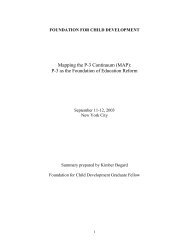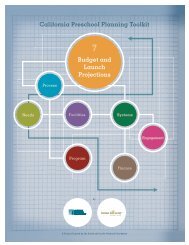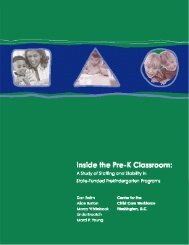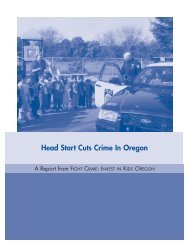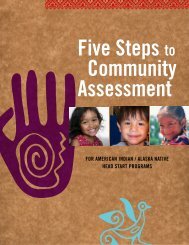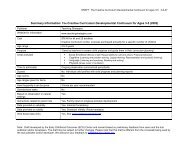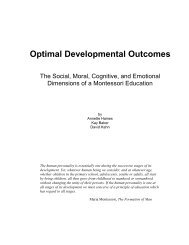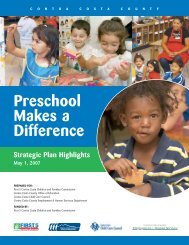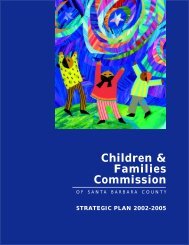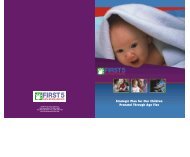Steps to Excellence Program Implementation Plan ... - Plan4Preschool
Steps to Excellence Program Implementation Plan ... - Plan4Preschool
Steps to Excellence Program Implementation Plan ... - Plan4Preschool
You also want an ePaper? Increase the reach of your titles
YUMPU automatically turns print PDFs into web optimized ePapers that Google loves.
<strong>Steps</strong> <strong>to</strong> <strong>Excellence</strong> <strong>Program</strong><br />
<strong>Implementation</strong> <strong>Plan</strong>: Launching a<br />
Child Care Quality Rating System<br />
in Los Angeles County<br />
Prepared by the<br />
Los Angeles County<br />
Policy Roundtable for Child Care<br />
Submitted <strong>to</strong> the Board of Supervisors<br />
Oc<strong>to</strong>ber 12, 2006
<strong>Steps</strong> <strong>to</strong> <strong>Excellence</strong> <strong>Program</strong> <strong>Implementation</strong> <strong>Plan</strong>:<br />
Launching a Child Care Rating System in Los Angeles County<br />
Introduction 5<br />
What is a Quality Rating System (QRS) 6<br />
Why is a QRS necessary 6<br />
What value would a QRS offer <strong>to</strong> families, providers and communities 7<br />
Who else is implementing QRS and what lessons can we learn 8<br />
<strong>Steps</strong> <strong>to</strong> <strong>Excellence</strong> <strong>Program</strong> (STEP): A QRS for Los Angeles County<br />
a. Guiding Principles 9<br />
Page<br />
b. What does STEP measure 11<br />
<strong>Implementation</strong> of STEP 11<br />
a. Opportunities for Collaboration 12<br />
b. STEP Pilot Communities and <strong>Implementation</strong> Goals 13<br />
c. STEP Pilot Project Budget 14<br />
d. STEP <strong>Implementation</strong> Schedule 15<br />
Conclusion 16<br />
Endnotes 18<br />
Attachment A – STEP for Centers<br />
Attachment B – STEP for Family Child Care Homes<br />
Attachment C – Letters of Interest <strong>to</strong> Participate and/or Support STEP<br />
a. The Child Abuse Prevention Center<br />
b. Department of Children and Family Services<br />
c. Department of Public Social Services<br />
d. Education Coordinating Council<br />
e. Vic<strong>to</strong>r Gordo, Pasadena City Council Member<br />
Attachment D – <strong>Implementation</strong> Details for Child Care Centers<br />
Attachment E – <strong>Implementation</strong> Details for Family Child Care Homes<br />
3
1. Introduction<br />
Three years ago, two members of the Policy Roundtable for Child Care (Roundtable) faced their<br />
own child care challenges. One, a new father, was investigating infant care, while the other was<br />
seeking preschool services for his grandchildren.<br />
These two prospective child care consumers, leaders in their professions, were decidedly<br />
unsettled by their child care searches. They knew that participating in a high quality child<br />
development program could be beneficial and that a poor quality program could have negative<br />
consequences for young children. But how were they <strong>to</strong> determine which programs were high<br />
quality Their confidence in the child care licensing system was shaken by news s<strong>to</strong>ries of<br />
convicted criminals working in programs and reductions in the number on-site inspections.<br />
Referrals and check lists were available – but the information <strong>to</strong> actually compare the quality of<br />
different programs was not readily accessible and confusing.<br />
The Roundtable became their venue where these frustrations were aired and where solutions<br />
were explored. Recognizing that these experiences were shared with families throughout the<br />
County, the Roundtable set out <strong>to</strong> design a voluntary child care quality rating system that would:<br />
• Provide parents with clear, concise information on the quality of individual child care<br />
settings serving children from infancy through preschool,<br />
• Distinguish programs that are meeting higher program standards,<br />
• Create incentives and provide supports so programs can achieve and maintain higher<br />
program standards,<br />
• Build a case for linking reimbursement rates <strong>to</strong> program quality, and<br />
• Provide benchmarks <strong>to</strong> determine if the quality of care in individual programs or<br />
communities is improving over time.<br />
Over the past three years and in conjunction with a variety of stakeholders, the Roundtable has<br />
developed the <strong>Steps</strong> <strong>to</strong> <strong>Excellence</strong> <strong>Program</strong> (STEP). STEP is a child care rating system which<br />
will provide families, providers and communities with critically important information on the<br />
quality of child care services. As proposed, participation in STEP would be voluntary and all<br />
licensed child care programs would be encouraged <strong>to</strong> engage in program improvements that<br />
have been shown <strong>to</strong> improve outcomes for children. Attention has been paid <strong>to</strong> align standards<br />
with child care licensing, and various funding and accreditation systems so as <strong>to</strong> minimize the<br />
administrative burden of participation. The Roundtable recognizes that technical assistance and<br />
support will be needed <strong>to</strong> ensure broad participation from family child care homes and child care<br />
centers.<br />
Given the size and complexity of Los Angeles County, we are presenting a detailed plan <strong>to</strong> pilot<br />
the implementation of STEP in specific communities in Los Angeles County. A number of<br />
organizations have expressed interest in supporting the implementation of STEP either<br />
financially or programmatically. With the support of the Board of Supervisors and these<br />
partners, the STEP could effectively narrow the gap between what we know and what we do <strong>to</strong><br />
4
promote the healthy development of the thousands of young children enrolled in child care and<br />
development programs throughout Los Angeles County.<br />
2. What is a Child Care Quality Rating System<br />
In Stair <strong>Steps</strong> <strong>to</strong> Quality, Anne Mitchell succinctly defined a Quality Rating System (QRS) as a<br />
method <strong>to</strong> assess, improve and communicate the level of quality in early care and education<br />
settings and highlighted the following five elements common <strong>to</strong> most QRS: 1<br />
a. Standards – Compliance with state child care licensing generally serves as the<br />
minimum, with two or more levels of quality criteria above licensing. Standards are<br />
based on early care and education research and practices that have gained wide<br />
acceptance.<br />
b. Accountability – Valid and reliable methods of assessment are used <strong>to</strong> moni<strong>to</strong>r<br />
compliance with standards and assign quality ratings.<br />
c. <strong>Program</strong>s & practitioner outreach & support – Outreach is conducted <strong>to</strong> promote<br />
participation and support is provided <strong>to</strong> programs <strong>to</strong> facilitate their meeting criteria<br />
expressed in the standards and improving their program quality.<br />
d. Financing incentives linked <strong>to</strong> compliance with quality standards – Incentives could<br />
be in the form of quality bonus payments, tiered reimbursement rates, quality grants<br />
and/or wage supplements.<br />
e. Parent education - Effectively communicate with families how the QRS works and how<br />
<strong>to</strong> use the information on program quality when choosing a child care program.<br />
3. Why is a Quality Rating System (QRS) necessary<br />
There are just over 3,000 (3,070) licensed child development centers and nearly 11,000<br />
(10,962) licensed family child care homes in Los Angeles County. Combined, these programs<br />
have an estimated capacity <strong>to</strong> care for 226,000 children ranging in age from six weeks <strong>to</strong> five<br />
years.<br />
Child care licenses issued by the California Department of Social Services, Community Care<br />
Licensing Division are intended <strong>to</strong> ensure the basic health and safety of child care programs.<br />
However, even this limited scope was undermined by California’s recent fiscal crisis:<br />
“Under standards implemented during the state budget crisis in 2003, California<br />
switched from annual moni<strong>to</strong>ring of day-care facilities <strong>to</strong> a system of inspecting only<br />
once every five years, one of the least-frequent moni<strong>to</strong>ring programs in the nation. But<br />
despite recent improvement efforts, inspections are still not happening often enough <strong>to</strong><br />
meet even the lower standard, audi<strong>to</strong>rs found.” 2<br />
Health and safety are essential - but far from exclusive - fac<strong>to</strong>rs in determining the quality of<br />
child development services. High quality child development services also address relationships,<br />
environments, and resources that support the healthy development of children and their<br />
families. Accreditation programs managed by the National Association for the Education of<br />
Young Children and the National Association for Family Child Care offer comprehensive<br />
5
assessments of child development program quality. These programs are national in scope and<br />
participation is voluntary. Unfortunately, only 7 percent of the child care centers and less than 2<br />
percent of the family child care homes in Los Angeles County are accredited.<br />
The quality of child development programs is of concern <strong>to</strong> parents and policy makers because<br />
research has shown that children who participated in high quality child care and development<br />
programs had better cognitive and social skills upon entering the K-12 education system, lower<br />
enrollment rates in special education, higher high school graduation rates, fewer arrests, and<br />
higher rates of employment than their peers who did not participate in such programs. 3 Children<br />
attending mediocre or poor quality program do not enjoy these benefits.<br />
“Research demonstrates that it is the quality of a program that is most important <strong>to</strong> a<br />
young child’s development. Indica<strong>to</strong>rs of quality that encourage conditions in which<br />
children are better able <strong>to</strong> learn and grow include: low teacher-child ratios, small group<br />
sizes, qualified teaching staff, positive teacher-child interactions, parental involvement,<br />
and access <strong>to</strong> comprehensive services such as health care and mental health services. 4<br />
Low-income and minority children can benefit fully from good schools only if they enter<br />
these schools ready <strong>to</strong> learn. Narrowing the achievement gap requires early childhood<br />
programs, staffed with professional teachers and nurses, and with curricula that<br />
emphasize not only literacy but social and emotional growth. Social class differences in<br />
vocabulary and conceptual ability develop by age 3. 5<br />
There is an unacceptably wide gap between what we know and what we do <strong>to</strong> promote<br />
healthy childhood development.” 6<br />
The quality rating system developed by the Policy Roundtable for Child Care, known as <strong>Steps</strong> <strong>to</strong><br />
<strong>Excellence</strong> <strong>Program</strong> (STEP) is designed <strong>to</strong> provide parents with objective and relevant<br />
information with which <strong>to</strong> compare child care options. The system is also intended <strong>to</strong> focus<br />
training and support for child care providers on program improvements which maximize positive<br />
outcomes for children, and <strong>to</strong> engage both licensed family child care homes and child care<br />
centers in making those program improvements.<br />
The Roundtable acknowledges that a significant number of young children are receiving regular<br />
child care services from relatives, friends and neighbors. These providers, who are frequently<br />
caring for their own children and those of one other family, are not required <strong>to</strong> be licensed. The<br />
Roundtable’s decision <strong>to</strong> limit participation in the QRS <strong>to</strong> licensed providers was in response <strong>to</strong><br />
the complexity of the task and the need <strong>to</strong> work with an identifiable population. This decision<br />
should not be viewed as valuing licensed care over license-exempt care.<br />
4. What value would STEP offer families, providers and communities in Los Angeles<br />
County<br />
STEP is designed <strong>to</strong> assess those aspects of child care programs which affect child outcomes,<br />
and <strong>to</strong> make that information available <strong>to</strong> parents in a clear and concise manner. Many of the<br />
program aspects which affect child outcomes are not obvious <strong>to</strong> the casual observer. For<br />
example, teacher education, retention and compensation have been shown <strong>to</strong> positively impact<br />
the language, math, and social skills of participating children through at least third grade.<br />
Research has also demonstrated that lower child <strong>to</strong> teacher ratios positively impact the quality<br />
of interactions between teachers and children. Opportunities for complex play and learning can<br />
be enhanced by the materials available in the classroom.<br />
6
Locally, Los Angeles Universal Preschool (LAUP) is using an abbreviated version of the STEP<br />
quality rating system. LAUP refers <strong>to</strong> their version as the 5-Star Quality Assessment and<br />
Improvement Scale. The scale is used <strong>to</strong> define the programmatic standards that LAUP<br />
classrooms must meet, inform parents about program quality, identify areas where technical<br />
support is needed, and determine the level of financial support. It should be noted that LAUP<br />
services are limited <strong>to</strong> four-year olds, and the 5-Star Quality Assessment and Improvement<br />
Scale is limited <strong>to</strong> those classrooms. <strong>Implementation</strong> of STEP would give parents of younger<br />
children a similar <strong>to</strong>ol <strong>to</strong> assess the quality of the prospective programs.<br />
STEP would also provide child care opera<strong>to</strong>rs with a focused message on indica<strong>to</strong>rs of<br />
high quality child development services for young children from birth through five. The difference<br />
between basic licensing standards and the standards required for accreditation is significant –<br />
so much so that many programs see accreditation as unattainable. By contrast, STEP is<br />
intended <strong>to</strong> involve programs from across the quality spectrum and <strong>to</strong> acknowledge incremental<br />
improvements in areas that impact child outcomes.<br />
By recognizing the quality of all programs, STEP effectively highlights programs that are<br />
providing high quality services. It is a long-term goal that reimbursement rates for publicly<br />
funded child care services would reflect the higher costs associated with higher quality<br />
programs.<br />
Millions of dollars are used each year <strong>to</strong> purchase child care services for clients of Los<br />
Angeles County. During Fiscal Year 2004-05, the Department of Public Social Services<br />
(DPSS) administered $104,550,000 in Stage 1 Child Care payments for Los Angeles County<br />
families participating in the CalWORKs <strong>Program</strong>. An additional $138,000,000, administered by<br />
community-based child care organizations, was available for families using Stages 2 and 3 child<br />
care. The Department of Children and Family Services (DCFS) administered a contract which<br />
included $12,225,839 in child care payments.<br />
Children in families who are receiving services from DPSS and/or DCFS are extremely<br />
vulnerable due <strong>to</strong> poverty, neglect and /or abuse. In many instances, these families are new <strong>to</strong><br />
social service institutions and the formal child care sec<strong>to</strong>r. Frequently, parents have limited<br />
time <strong>to</strong> choose a child care setting and varying levels of support <strong>to</strong> make an informed choice.<br />
STEP could provide assurances that these families, who could reap significant benefits from<br />
quality child care, are in fact accessing high quality services.<br />
5. Who else is implementing quality rating systems and what lessons can we learn<br />
Quality Rating Systems (QRS) are a rapidly advancing approach for improving child care<br />
quality. United Way of Orange County launched a program this past spring <strong>to</strong> assess the<br />
quality of child care centers. Fourteen states are currently operating QRS that encompass both<br />
child care centers and family child care homes:<br />
Colorado<br />
District of Columbia<br />
Iowa<br />
Kentucky<br />
Maryland<br />
Montana<br />
New Hampshire<br />
New Mexico<br />
North Carolina<br />
Oklahoma<br />
Pennsylvania<br />
Tennessee<br />
Vermont<br />
Wyoming<br />
7
In addition, 23 other states report operating tiered reimbursement systems, which pay higher<br />
rates <strong>to</strong> programs meeting standards above local licensing regulations. The experiences of<br />
these “pioneers” offer guidance on what a QRS can contribute <strong>to</strong> the field of early care and<br />
education.<br />
In 1998, the Okalahoma Department of Human Services launched its “Reaching for the Stars”<br />
program. This program was intended <strong>to</strong> improve the quality of child care, particularly for children<br />
receiving child care subsidies, by establishing quality criteria beyond licensing standards.<br />
<strong>Program</strong>s meeting these enhanced standards were reimbursed at higher rates for their services.<br />
Between Fall 2001 and Spring 2002, a sample of star-rated child care centers and family child<br />
care homes was identified. Observations were conducted at the sample sites using the<br />
Caregiver Interaction Scale, and Family Child Care Environment, Infant/Toddler or Early<br />
Childhood Environment Rating Scale(s). Results of this evaluation revealed that:<br />
• The quality of care available <strong>to</strong> preschool-age children had improved between 1999 and<br />
2002.<br />
• Many centers raised their Star levels between 1999 and 2002.<br />
• Family child care home quality varied by Star level, with higher levels of quality being<br />
offered in homes with high ratings. 7<br />
North Carolina moved from a two- <strong>to</strong> five-star child care licensing system in 1999. The purpose<br />
of the five-star system was <strong>to</strong> emphasize the importance of child care quality and <strong>to</strong> provide<br />
parents with additional information <strong>to</strong> compare their child care options. Research conducted in<br />
December 2000 revealed a significant relationship between the star rating level of a child care<br />
center and other indica<strong>to</strong>rs of program quality. 8<br />
The RAND Corporation is in the process of conducting a five-year evaluation of Educare, a<br />
public-private partnership created <strong>to</strong> improve child care quality for Colorado's children. With<br />
OMNI, a Denver-based non-profit research institution, RAND will validate Educare’s quality<br />
rating system. To do so, the RAND/OMNI team is conducting assessments of children’s<br />
cognitive and social functioning as well as utilizing alternative quality indica<strong>to</strong>rs in a set of child<br />
care centers and family child care homes that are receiving public funds <strong>to</strong> improve child care<br />
quality. Study findings should assist Educare in making any needed adjustments <strong>to</strong> its rating<br />
system. Study data should substantially increase understanding of the effects of child care<br />
quality on children. Results should also contribute <strong>to</strong> improved child care practice, <strong>to</strong> new<br />
understandings about how <strong>to</strong> leverage quality improvement funds, and <strong>to</strong> addressing other<br />
important policy questions in the child care arena.<br />
6. <strong>Steps</strong> <strong>to</strong> <strong>Excellence</strong> <strong>Program</strong>: A QRS for Los Angeles County<br />
a. Guiding Principles<br />
The following principles have guided the development of STEP for child care centers and family<br />
child care homes in Los Angeles County:<br />
• Voluntary and beneficial - Participation in STEP will be voluntary and beneficial <strong>to</strong><br />
programs, effectively communicating <strong>to</strong> parents the value of the services provided.<br />
8
• Inclusive – The goal is <strong>to</strong> include as many programs as possible in STEP,<br />
acknowledge incremental quality improvements, and promote a common<br />
understanding of high quality child development services among parents and child<br />
care providers.<br />
• Aligned – The intent is <strong>to</strong> minimize administrative burdens associated with<br />
participation in STEP while also supporting involvement in various quality initiatives.<br />
Therefore:<br />
o<br />
Step 1 is aligned with basic licensing standards.<br />
o Step 3 is largely aligned with Title 5 of the California Education Code, which<br />
regulates programs funded by the California Department of Education and<br />
with the 3-Star level of the LAUP quality rating system.<br />
o Step 5 is largely aligned with the 5-Star level of the LAUP quality rating<br />
system and the accreditation standards of the National Association for the<br />
Education of Young Children and the National Association for Family Child<br />
Care. Child care providers participating in these initiatives will be able <strong>to</strong><br />
utilize some LAUP and accreditation materials <strong>to</strong> document compliance with<br />
the QRS.<br />
• Standards are research-based or reflect best practices – The standards in STEP<br />
have been shown by research or best practices <strong>to</strong> positively impact child and family<br />
outcomes.<br />
o Rating Instrument – With support from the First 5 LA Commission, the quality<br />
rating instruments were field tested in 2005 by the Center for Improving Child<br />
Care Quality at the University of California, Los Angeles. It was determined<br />
that the rating instruments are capable of assessing program quality.<br />
Recommendations made at the time of the field test <strong>to</strong> further refine the<br />
instruments have been adopted.<br />
o Ratios – There is a general consensus among early childhood professionals<br />
and researchers that smaller classes and lower child-adult ratios improve<br />
quality in early childhood programs. 9<br />
o Staff qualifications – The education levels of early childhood educa<strong>to</strong>rs, as<br />
well as their specialized training in early childhood and child development,<br />
directly relate <strong>to</strong> the positive learning and development of children. 10<br />
o Staff compensation and turnover – Teacher education is highly correlated<br />
with teacher wages and turnover. Teachers with more education are paid<br />
more and tend <strong>to</strong> stay at their jobs longer than those who are less educated<br />
and paid less. 11<br />
• Support and technical assistance – Efforts will be made <strong>to</strong> facilitate the successful<br />
participation of programs in STEP by expanding and mobilizing existing training and<br />
support resources.<br />
9
• “Prepping for the test”– <strong>Program</strong>s are encouraged <strong>to</strong> carefully review STEP criteria<br />
and <strong>to</strong> integrate policies and practices, which align with STEP standards, in<strong>to</strong> their<br />
daily operations.<br />
The STEP rating instruments incorporate nationally recognized assessment <strong>to</strong>ols that are<br />
frequently used <strong>to</strong> measure both process and structural quality of child care services.<br />
b. What does STEP measure<br />
A copy of the STEP rating instruments and companion documents are included in Attachment<br />
A. Briefly, STEP is composed of the following components:<br />
(1) Regula<strong>to</strong>ry compliance – Documentation is provided showing that the facility is in<br />
compliance with the California Department of Social Services, Community Care<br />
Licensing Division, local Fire and, if applicable, Health regulations.<br />
(2) Teacher/Child Relationships – This component includes the program’s self report<br />
on teacher and staff <strong>to</strong> child ratios, a reviewer’s confirmation of those ratios, and<br />
scores on the Adult Involvement Scale (AIS). The AIS will be conducted by a<br />
trained evalua<strong>to</strong>r.<br />
(3) Learning Environment – A trained evalua<strong>to</strong>r will administer and score the<br />
appropriate Environment Rating Scale(s).<br />
(4) Identification and Inclusion of Children with Special Needs – The program will<br />
provide documentation of their policies regarding the inclusion of children with<br />
special needs, as well as their practices <strong>to</strong> conduct, in conjunction with parents,<br />
developmental screens on all participating children.<br />
(5) Qualifications and Working Conditions – The program provides documentation of<br />
staff qualifications, compensation, retention and professional development.<br />
(6) Family and Community – The program provides documentation of strategies<br />
used <strong>to</strong>:<br />
6. <strong>Implementation</strong> of STEP<br />
(i) welcome and encourage involvement all enrolled families<br />
(ii) foster strong reciprocal relationships with families,<br />
(iii) build on family strengths and social connections, and<br />
(iv) facilitate connections between parents and relevant community<br />
resources.<br />
The size of Los Angeles County and the density of its population make implementation of even<br />
good ideas challenging. The number of licensed child care providers (child care centers and<br />
family child care homes) in Los Angeles County is larger than that of 46 states. 12 As a result,<br />
the Roundtable recognizes that implementation of STEP may be best accomplished through a<br />
phase–in process, beginning with a pilot. The Roundtable recommends that the pilot be<br />
launched in strategically identified communities in Los Angeles County so that, at the end of the<br />
pilot period, we will better understand how the rating system impacts:<br />
10
• the child development choices of families receiving subsidized services and families<br />
paying the full cost of these services, and<br />
• the operations of child development programs that are fully subsidized and those that<br />
rely on parent fees.<br />
a. Opportunities for Collaboration<br />
Just as STEP rating instruments were designed <strong>to</strong> align with existing systems, implementation<br />
is intended <strong>to</strong> be accomplished in collaboration with organizations currently working with<br />
families and child development programs. The following list describes some of the collaborative<br />
opportunities that have been explored and highlights potential partners that have expressed<br />
interest in supporting STEP:<br />
1. Outreach <strong>to</strong> families<br />
• Child care resource and referral agencies: include information on STEP in the child<br />
care referral process, on organization Web pages and in newsletters.<br />
• Department of Children and Family Services: encourage families receiving<br />
subsidized child care services through the Department <strong>to</strong> use STEP in making their<br />
child care choices, and incorporate information on STEP in<strong>to</strong> written materials and<br />
Web page where child care issues are discussed.<br />
• Department of Public Social Services: in conjunction with child care program<br />
subcontrac<strong>to</strong>rs, inform families receiving CalWORKs child care subsidies of STEP<br />
and incorporate STEP information in<strong>to</strong> the child care Web site maintained by the<br />
Department.<br />
• LAUP: include a link <strong>to</strong> the Office of Child Care Web page, which posts rated child<br />
care programs.<br />
• Office of Child Care: include information for parents and a listing of rated programs<br />
on Web site.<br />
2. Outreach <strong>to</strong> programs<br />
• Child care resource and referral agencies: include information on STEP in<br />
newsletters and work with centers and family child care providers.<br />
• Child Care <strong>Plan</strong>ning Committee: incorporate regular reports in<strong>to</strong> monthly meetings<br />
and assist with program recruitment.<br />
• Office of Child Care: post information on STEP, including training opportunities, on<br />
Web page.<br />
3. Technical assistance <strong>to</strong> programs<br />
• Child care resource and referral agencies: align training and support activities with<br />
components of the STEP.<br />
11
• Investing in Early Educa<strong>to</strong>rs <strong>Program</strong>: sponsor training that aligns with the<br />
components of the STEP, such as the Environment Rating Scales, developmental<br />
screening <strong>to</strong>ols and program management.<br />
• Child Abuse Prevention Center: collaborate on training child care staff and family<br />
child care providers on the Family and Community portion of STEP, thereby<br />
promoting the Strengthening Families model of child abuse prevention.<br />
• Los Angeles County Office of Education (LACOE) - Child Care Training Institute:<br />
align training and support activities with components of STEP.<br />
4. Administration of STEP rating:<br />
• Community Care Licensing Division of the California Department of Social Services<br />
and the Environmental Health Section of the Los Angeles County Department of<br />
Health Services: verify the status of applicants <strong>to</strong> STEP.<br />
• <strong>Program</strong>s that include LAUP classrooms would not be required <strong>to</strong> repeat the Early<br />
Childhood Environment Rating Scale (ECERS) observation.<br />
• The City of Santa Monica and Connections for Children are interested in using the<br />
STEP as part of a tiered reimbursement system for subsidized child care in Santa<br />
Monica.<br />
b. Pilot Project Communities and <strong>Implementation</strong> Goals<br />
Building on the collaborations described above, the Roundtable has tentatively identified 60<br />
cities and the Prevention Project target communities <strong>to</strong> launch STEP. The first chart on the next<br />
page identifies the communities, the pool of potential child care programs in each, the number<br />
of accredited centers and family child care homes, and LAUP sites.<br />
Combined, there are currently over 400 child care centers, 73 of which include infant/<strong>to</strong>ddler<br />
services, and 1,998 licensed family child care homes. This provides a pool of just over 2,400<br />
programs <strong>to</strong> participate in STEP.<br />
Our goal is <strong>to</strong> involve 210 or 50 percent of the child care centers and 400 or 20 percent of the<br />
licensed family child care homes in STEP over a two year period. We are also proposing that<br />
as a part of the STEP evaluation, at least 25 percent of all participating centers and 10 percent<br />
of all participating family child care homes would be rated during Year 3 as a part of the STEP<br />
evaluation.<br />
12
Proposed<br />
Pilot Communities<br />
Infant<br />
*<br />
c. STEP Pilot <strong>Program</strong> Budget<br />
Centers<br />
LAUP<br />
Preschool Sites<br />
NAEYC<br />
Accredited<br />
The Office of Child Care currently administers a number of programs funded by the California<br />
Department of Education. The recent award of dedicated funding <strong>to</strong> support the operation of<br />
the Centralized Eligibility List has created new flexibility in the administration of the Local Child<br />
Care <strong>Plan</strong>ning contract. <strong>Implementation</strong> of a child care quality rating system was listed as a<br />
goal in the Child Care <strong>Plan</strong>ning Committee’s 10-year strategic plan. As a result, the use of<br />
Local Child Care <strong>Plan</strong>ning contract funds <strong>to</strong> support the implementation of such a system is<br />
consistent with both local child care planning efforts and contract funding terms.<br />
The Office of Child Care can therefore dedicate the following staff and operational support <strong>to</strong> the<br />
implementation of STEP:<br />
• Special Services Assistant III (20 percent time) $ 21,948<br />
• Chief <strong>Program</strong> Specialist (10 percent time) $ 10,374<br />
• <strong>Program</strong> Specialist III (25 percent time) $ 18,000<br />
• <strong>Program</strong> Specialist III (100 percent time) $ 72,000<br />
(Currently allocated, but vacant position)<br />
• Senior Secretary III (20 percent time) $ 9,854<br />
$132,176<br />
• Employee benefits $ 55,514<br />
$187,690<br />
• General operating costs: space,<br />
equipment, phone, etc. $ 25,000<br />
• Total $212,690<br />
Family Child Care Homes<br />
LAUP NAFCC<br />
Homes Sites Accredited<br />
Prevention Initiative<br />
Florence/Fires<strong>to</strong>ne 90001 1 7 1 0 60 1 0<br />
Wilming<strong>to</strong>n 90744 2 11 1 0 40 0 1<br />
Pacoima/Arleta 91331 3 21 2 3 95 3 3<br />
Palmdale 93550 3 16 2 2 195 2 2<br />
Inglewood 8 38 2 2 350 1 5<br />
Long Beach 27 136 11 14 504 9 20<br />
Palmdale (93550, 93551) 4 25 2 2 403 2 4<br />
Pasadena 13 70 2 6 178 0 1<br />
Pomona 5 45 7 1 141 1 0<br />
Santa Monica 7 50 3 14 32 4 1<br />
Total 73 419 33 44 1,998 23 37<br />
Proposed Participants 50% - 210 20%- 400<br />
*While centers are required <strong>to</strong> hold separate licenses <strong>to</strong> provide infant care, most infant programs operate as a<br />
part of a child development program serving multiple age groups. Accredited and LAUP sites per 6/20/06 listing<br />
on respective Web sites.<br />
13
Additional STEP costs would include the following:<br />
Budget Items Year 1 Year 2 Year 3<br />
<strong>Program</strong> Observations $300,000 $300,000<br />
Data analysis $5,000 $5,000<br />
Project Evaluation<br />
• Follow-up observations $300,000<br />
• Analysis, report $60,000<br />
Sub<strong>to</strong>tal $305,000 $305,000 $360,000<br />
STEP incentives $40,000 $80,000 $80,000<br />
Training/Coaching $75,000 $100,000 $100,000<br />
Materials development & distribution $25,000 $15,000 $10,000<br />
Sub<strong>to</strong>tal $140,000 $195,000 $190,000<br />
Grand Total $445,000 $500,000 $550,000<br />
This budget would allow for a minimum of 110 child care center and 190 family child care home<br />
observations in both Year 1 and Year 2 or 50 percent of centers and 20 percent of the family<br />
child care homes in the pilot communities. The evaluation component would include follow-up<br />
observations of 50 percent of participating centers and family child care homes.<br />
d. Potential Funding Sources<br />
The Roundtable has explored a variety of funding sources <strong>to</strong> support the launching of the STEP<br />
pilot project including First 5 LA, multiple private foundations and two municipalities. While firm<br />
commitments have not been made, the results of these initial explorations have been extremely<br />
positive. One potential partner has already identified incentive funds <strong>to</strong> encourage participation<br />
in the quality rating system.<br />
e. STEP <strong>Implementation</strong> Schedule<br />
Time Frame Task Responsible Parties<br />
9/06-12/06 Research and secure funding commitment <strong>to</strong><br />
conduct on-site ECERS and AIS estimated at<br />
$305,000 - $360,000 per year, beginning July 1,<br />
2007. Determine mechanism <strong>to</strong> secure outside<br />
services.<br />
Fill <strong>Program</strong> Specialist III (PSIII) position <strong>to</strong> act as<br />
lead on this program. Funds are currently available.<br />
9/06 – 4/07 Secure funding/resources <strong>to</strong> provide incentives <strong>to</strong><br />
minimize the cost burden of participation in STEP.<br />
Policy Roundtable for<br />
Child Care, with staff<br />
support<br />
Office of Child Care<br />
(OCC) – Service<br />
Integration Branch<br />
Roundtable, staff<br />
9/06 – 6/07 Secure funding <strong>to</strong> evaluate the STEP program. Roundtable, staff<br />
12/06 – 1/07 Finalize agreements with collaborating partners. PS IIII<br />
14
Time Frame Task Responsible Parties<br />
1/07 Host event with community stakeholders, including<br />
major child care opera<strong>to</strong>rs in Los Angeles County, <strong>to</strong><br />
prepare for the July launch of the rating system.<br />
Roundtable, staff<br />
1/07 – 8/07<br />
Ongoing<br />
1/07 – 4/07<br />
Ongoing<br />
Roger and Bonnie Neugebauer, edi<strong>to</strong>rs of the Child<br />
Care Exchange are willing <strong>to</strong> facilitate session.<br />
Create and train the Roundtable STEP Review<br />
Committee.<br />
Provide ongoing support <strong>to</strong> Committee<br />
Initiate recruitment of program <strong>to</strong> participate in<br />
STEP. Creation and distribution of materials and<br />
Web site.<br />
Continue promotion and recruitment effort, updating<br />
materials and responding <strong>to</strong> inquiries.<br />
Roundtable Chair with<br />
staff support, County<br />
Counsel, Community<br />
Care Licensing<br />
PS III with support from<br />
the OCC, Roundtable,<br />
<strong>Plan</strong>ning Committee and<br />
partners<br />
PS III with support from<br />
the OCC, Roundtable,<br />
<strong>Plan</strong>ning Committee and<br />
partners<br />
5/07 – 6/09 Coordinate review of applications, verifications from<br />
Community Care Licensing and Health Services,<br />
schedule on-site observations and forward<br />
recommendations <strong>to</strong> the STEP Review Committee.<br />
PS III, OCC<br />
Coordinate review of annual program updates.<br />
7/07 – 1/08 Secure program evalua<strong>to</strong>r. PS III, OCC, SIB<br />
1/08 – 6/08 Finalize data collection procedures & project<br />
evaluation.<br />
PS III, OCC, Vendor<br />
7/09 – 12/09 Analysis and preparation of final report. Evaluation Team<br />
7. Conclusion<br />
The Roundtable is seeking support from the Board of Supervisors <strong>to</strong> implement the pilot phase<br />
of STEP. Endorsement by the Board of Supervisors will facilitate the Roundtable’s ability <strong>to</strong><br />
finalize the various partnerships identified in this plan and fully implement the assessment,<br />
training and support, promotion and evaluation components of STEP.<br />
Based on the experience of other entities who have established child care quality rating<br />
systems, STEP has the potential <strong>to</strong>:<br />
15
• Provide parents in the pilot communities with clear, concise information on the quality of<br />
individual child care settings serving children from infancy through preschool,<br />
• Distinguish programs in the pilot communities that are meeting higher program<br />
standards,<br />
• Create an incentive for programs <strong>to</strong> achieve and maintain higher program standards,<br />
• Build a case for linking reimbursement rates <strong>to</strong> program quality, and<br />
• Provide benchmarks <strong>to</strong> determine if the quality of care in individual programs or<br />
communities is improving over time.<br />
STEP is a critically important program, designed <strong>to</strong> close the gap between what we know and<br />
what we do <strong>to</strong> improve the lives of young children in Los Angeles County.<br />
16
8. Endnotes<br />
1 Mitchell, Anne. “Stair <strong>Steps</strong> <strong>to</strong> Quality.” United Way of America, July 2005, p. 4. Available on the Web at<br />
the National Child Care Information Center<br />
http://national.unitedway.org/files/pdf/sb6/stairsteps<strong>to</strong>qualityguidebook_finalforWEB.pdf<br />
2 Benson, Clea. “Child-care safety falls short state audi<strong>to</strong>r says,” Sacramen<strong>to</strong> Bee, May 28, 2006.<br />
3 Examples of research on the impact of quality child development services The High Scope Perry<br />
Preschool Study Through Age 40 by Lawrence Schwienhart, www.highscope.org; The Children of the<br />
Cost, Quality and Outcomes Study Go <strong>to</strong> School, Carollee Howes, et all, 1999; Success in Early<br />
Intervention: The Chicago Child-Parent Centers, Arthur Reynolds.<br />
4 Reaching All Children Understanding Early Care and Education Participation Among Immigrant<br />
Families, 2006, CLASP, www.clasp.org.<br />
5 Rothstein, Richard. “Reforms that Could Help Narrow the Achievement Gap,” excerpted from Class and<br />
Schools: Using Social, Economic and Educational Reform <strong>to</strong> Close the Black-White Achievement Gap,<br />
Teachers College Press, 2004.<br />
6<br />
Shonkoff, Jack. Quoted by Kathy Cobb, Managing Edi<strong>to</strong>r of The Region in “The ABCs of ECD:<br />
Conference explores the latest research on the economic of early childhood development,” December<br />
2003. Available at http://www.minneapolisfed.org/pubs/region/03-12/ecd.cfm.<br />
7 Norris, Deborah, et all. “Reaching for the Stars” Center Validation Study, Executive Summary,<br />
November 2003 and “Reaching for the Stars” Family Child Care Home Validation Study, August 2004.<br />
8 Bryant, Donna, et all. Validating North Carolina’s 5-Star Child Care Licensing System, Smart Start,<br />
Frank Porter Graham, University of North Carolina, February 2001.<br />
9 Prekindergarten Policy Framework, a project of the FPG Child Development Institute, UNC-CH, section<br />
on program standards, Class Size and Adult Child Ratios, available at:<br />
http://www.fpg.unc.edu/~npc/framework/framework.cfmsection_num=7&subsection_num=1.<br />
10 Prekindergarten Policy Framework, a project of the FPG Child Development Institute, UNC-CH, section<br />
on program standards, Teacher Qualifications, available at:<br />
http://www.fpg.unc.edu/~npc/framework/framework.cfmsection_num=7&subsection_num=1.<br />
11 Prekindergarten Policy Framework, a project of the FPG Child Development Institute, UNC-CH, section<br />
on program standards, Teacher Qualifications, available at:<br />
http://www.fpg.unc.edu/~npc/framework/framework.cfmsection_num=7&subsection_num=1.<br />
12 Findings from the 2005 Child Care Licensing Study produced by the National Association for<br />
Regula<strong>to</strong>ry Administration and the National Child Care Information Center, released April 2006.<br />
17



